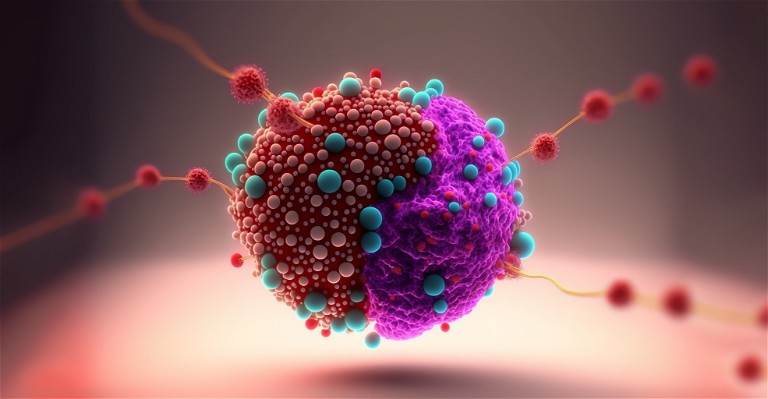ONCOLOGY
Repairing not destroying: the future of targeted cancer drug design
Lukasz Jaremko from King Abdullah University of Science and Technology, Saudi Arabia explains how using nuclear magnetic resonance to study the dynamics of epigenetic targets may enable drug development that does not kill but resets cancer cells to a benign state
The drug industry has long been reeling from the cost of bringing a drug to market. Cancer drugs suffer from an even higher cost and higher attrition rate than other drugs, with 95% of phase 1 drugs failing to reach approval. These discouraging circumstances reflect the multilevel complexity of the disease. Different cancer types (haematological malignancies, solid tumours), different causes (genetic, environmental) and different promoters (genetic mutations, tumour microenvironments) all make a general therapeutic strategy difficult.
These features suggest cancer deserves a distinct perspective compared with other diseases. While cancer afflicts any age, 90% of patients are over 50 years old. For this older cohort, the disease can be seen as age-related, since many emerge following somatic mutations and exposure to certain environmental factors. However, unlike other age-related diseases, including neurodegeneration, myocardial infarctions and sarcopaenia, cancers are the result of uninhibited cell growth and proliferation, not cell death. Yet standard cancer therapies, including chemotherapy, radiotherapy, surgery and, most recently, immunotherapy, all have the same goal in mind: to eradicate the cancer by killing the pathological cells.
If we distinguish cancer from other age-related diseases, then it is not unreasonable to assume other therapeutic outcomes may also warrant consideration. Somatic mutations in epigenetic enzymes result in dysregulated gene expressions that lead to the cancer. In this scheme, a cancer cell reflects complex epigenetics that if perturbed strategically, by selectively targeting the dysregulated enzyme, may reset the cell to a healthy state. In other words, drugs need not be toxic to the cell. Instead, by focusing on epigenetic targets, pathological gene expressions can be modulated so that the cancer progression is halted and possibly reversed (of course, killing the cancer cells also remains an option). Already, several approved epi-drugs are on the market, with many more in the pipeline.
Among the many therapeutic targets, biomolecules, like enzymes, are not rigid entities but operate dynamically by constantly adjusting their architecture. Recent advancements in de novo protein structure prediction methods and experimental observation techniques have provided a wealth of information about these molecules in static states. Yet, our understanding of proteins remains insufficient without insights into the protein dynamics, including alternative minor states like cryptic binding sites (CBS). However, elucidation of the molecular motions for drug design has been lagging because of our inability to probe CBS at relevant time scales.
The temporal range we are dealing with begins in the femtoseconds and moves all the way to the milliseconds and, in some cases, seconds, meaning a window that spans over 14 magnitudes should be considered. Thus, computational and quantitative techniques must be incorporated into the drug design strategy, including molecular dynamics, cryo-electron microscopy, X-ray crystallography and nuclear magnetic resonance (NMR).
For decades, NMR has been a standard technique in drug design to decipher molecular structures and interactions. The industry has depended on NMR to assess target druggability, hit validation and hit optimisation. NMR’s value in fragment-based screening, in addition to high-throughput screenings, has allowed the industry to identify more versatile starting compounds for drug development faster and at lower cost. Finally, NMR can resolve structures of protein complexes that are not feasible with other experimental structural techniques.
Target identification and validation – who is the prime cancer driver?
In the last several decades, a strong consensus has concluded that cancer is not solely the result of mutations in oncogenes and tumour suppressor genes; mutations in epigenetic biomolecules, such as methylases, acetyltransferases and non-coding RNA, are sometimes the primary factors. The effects of these mutations can be seen in gene transcription and DNA repair to ultimately imbue rapacious metabolic demands by the cell. Lung cancers, for example, have one of the worst outcomes among all cancers. Most patients are smokers (>80%), but only one in ten smokers will develop the disease, pointing the finger to a genetic disposition. Indeed, in lung cancer patients, at least one of four oncogenes and tumour suppressor genes are mutated.1

However, several epigenetic alterations have also been associated with the cancer and affect the expression of a much larger set of genes. Mutated enzymes regulating the methylation status are associated with gene silencing and chromosomal instability, while those associated with the acetylation status lead to translation remodelling. The pathological outcome is the unsustainable promotion of cell growth, proliferation and migration as well as immune evasion. Conversely, inhibitors, activators and degraders of these epigenetic enzymes have shown indications of resetting the epigenetic landscape to a non-pathological state. Intuitively, the primary factor of the cancer makes the best target, but its identification is rarely trivial. A recent misidentified example is FGFR1, which had been considered a main driver in lung squamous cell carcinoma, but clinical trials testing its inhibitors have shown no benefit. A study using NMR would later suggest that a better target is the methyltransferase NSD3.2 NSD3 is an enzyme coded on the same chromosomal region as FGFR1 and frequently shows genetic alterations with the disease. The study found that mutations disrupted the autoinhibitory loop of NSD3, resulting in increased histone methylation. In turn, the expression of oncogenes was enhanced, accelerating the cancer in a mouse model. The ability of NMR to resolve the dynamics of the enzyme unequivocally linked the dynamic structure of NSD3 with the pathological cause, providing both an explanation for why inhibitors of the expected primary factor (FGFR1) have been ineffective and pointing the finger to a new candidate target.
Cryptic binding sites – drugging the ‘undruggable’
Cancer is a finicky enemy that mutates as part of its defence mechanism to develop drug resistance. This adaptation demands a constant search for new targets. Moreover, numerous validated cancer-related targets are ‘undruggable’, mainly due to their flat surface, which makes them difficult for small molecules to bind. CBS represent a second binding pocket on the same target that is exposed in specific dynamic conformation(s) that is difficult to detect experimentally. Technological advances have made NMR suitable for these searches, because it can resolve ‘open’ and ‘closed’ CBS even when the equilibrium heavily favours the ‘closed’ state. An exciting example involves a common motif in proteins of higher eukaryotes that regulates transcription and epigenetics: Broad-complex, Tramtrack and Bric-à-brac (BTB) domains. These domains have been regarded for decades as ‘undruggable’. NMR explained why among three proteins sharing conserved BTB domains, small molecules bound to only one.3 A fragment-based screening using NMR found several ligands bound to MIZ1 but not the two other analogues, LRF and KAISO, despite sharing highly similar static structures. What separated MIZ1 was its slower conformational dynamics (μ s-ms scale), which exposed its open CBS to detection. In contrast, the other BTBs remained closed.
The binding of a ligand to a CBS may stabilise the target protein in a conformation that enhances drug interactions and desired effects. This premise was demonstrated for certain mutations that lead to drug resistance in non-small lung cancer against osimertinib, a tyrosine kinase inhibitor for epidermal growth factor receptor. The sensitivity was recovered when adding a second compound that binds to a CBS in the receptor.4 The heterogeneity of cancer suggests a larger number of candidate targets than most diseases. Among these are epigenetic factors, which, because they regulate many oncogenes and tumour suppressor genes, frequently show complex effects. Their dynamics also add complexity to their study and require experimental validation for the drug design. Even then, many of the validated targets are deemed ‘undruggable’ without the identification of a CBS. NMR’s capability to illuminate the dynamics from the atomic level is well suited for this search, as a broad temporal range of structural dynamics can be resolved. Constant improvements in instrumentation and sample preparation are enabling experiments on a wider range of specimens, enhancing the impact of NMR in drug discovery. Moreover, user-friendly software is lowering the barrier of entry for the non-expert. This will invite more researchers to incorporate NMR into their work, which will only accelerate the detection of CBS in ‘undruggable’ proteins, thus facilitating the development of safe and effective cancer epi-drugs.
References
1. doi: 10.1038/nature25183
2. doi: 10.1038/s41586-020-03170-y
3. doi: 10.1038/s41467-022-34599-6
4. doi: 10.1016/j.jtho.2019.07.016

Lukasz Jaremko is an associate professor leading the Molecular Diagnostics and Drug Discovery (MD3) team in the in Bioscience and Bioengineering Division at King Abdullah University of Science and Technology, Saudi Arabia. He employs and develops advanced structural biology techniques to elucidate protein dynamics and interactions for drug design. In particular, he is an experienced structural and chemical biologist working on the identification and verification of druggable epigenetic protein targets related to cancer.